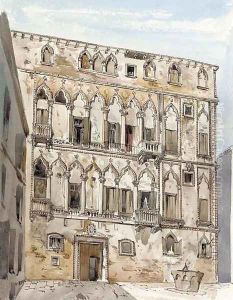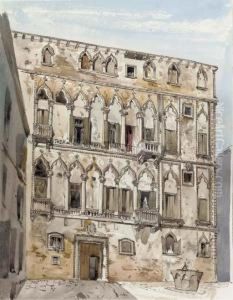George Edmund Street Paintings
George Edmund Street was an eminent English architect born on June 20, 1824, in Woodford, Essex. He was a leading figure in the Victorian Gothic Revival architecture movement, which sought to revive medieval Gothic architectural forms. Street's passion for Gothic architecture was not only rooted in its aesthetic qualities but also in its moral and spiritual associations, reflecting the Victorian era's complex relationship with religion and historicism.
Street began his architectural education as an apprentice to the architect George Gilbert Scott, another key figure in the Gothic Revival movement. This apprenticeship was crucial in shaping Street's architectural style and philosophy. In 1849, he started his own practice, which quickly gained a reputation for high-quality church designs. Street's work was characterized by meticulous attention to detail, innovative use of materials, and a deep respect for medieval architecture's craftsmanship and integrity.
One of his most famous works is the Royal Courts of Justice in London, completed posthumously in 1882. This monumental building is a testament to Street's mastery of Gothic design and his ability to adapt it to the needs of a modern public building. Throughout his career, Street also worked on numerous churches, cathedrals, and secular buildings across the United Kingdom and in continental Europe, particularly in Switzerland and France.
Street was not only a practicing architect but also an academic and a writer. He published several influential books on architecture, including 'Some Account of Gothic Architecture in Spain,' which reflected his meticulous research and keen observational skills. His writings and buildings significantly influenced the subsequent generation of architects and contributed to the enduring popularity of the Gothic Revival movement.
George Edmund Street's contributions to architecture were widely recognized during his lifetime. He was elected as a Royal Academician and received various honors for his work. Street passed away on December 18, 1881, in London, but his legacy continues to be celebrated for its significant impact on Victorian architecture and beyond. His devotion to the Gothic Revival movement and his innovative approach to design have cemented his place as one of the 19th century's most influential architects.









